Most people love flowers, whether they give them, receive them, or decide to grow them independently. They come in many types, but there are annual flowers of all descriptions to please the senses no matter what season it is. Some varieties of annual flowers bloom for more extended periods than others.
Perennial vs. Annual
You may wonder about the difference between ‘perennial’ and ‘annual’ plants. Perennials are planted once and come up every year, while annuals live for a single growing season. Some flowers bloom longer than others.
We have assembled a list of 28 annual flowers with long blooming periods to brighten your yard or garden. Let's take a look at them here:
Jump to:
- Perennial vs. Annual
- 1. Sweet Alyssum
- 2. Angelonia
- 3. African Daisy
- 4. Celosia
- 5. Dianthus
- 6. Garden Cosmos
- 7. Snapdragon
- 8. Geranium
- 9. Flowering Kale
- 10. Latana
- 11. Sweet Pea
- 12. Marigold
- 13. Flowering Stock
- 14. Mealycup Sage
- 15. English Primrose
- 16. Pentas
- 17. Calendula
- 18. Petunia
- 19. Nasturtium
- 20. Annual Vinca
- 21. Begonia
- 22. Zinnia
- 23. Cornflower
- 24. Impatiens
- 25. Pansy
- 26. Poppy
- 27. Calibrachoas
- 28. Ageratum
1. Sweet Alyssum
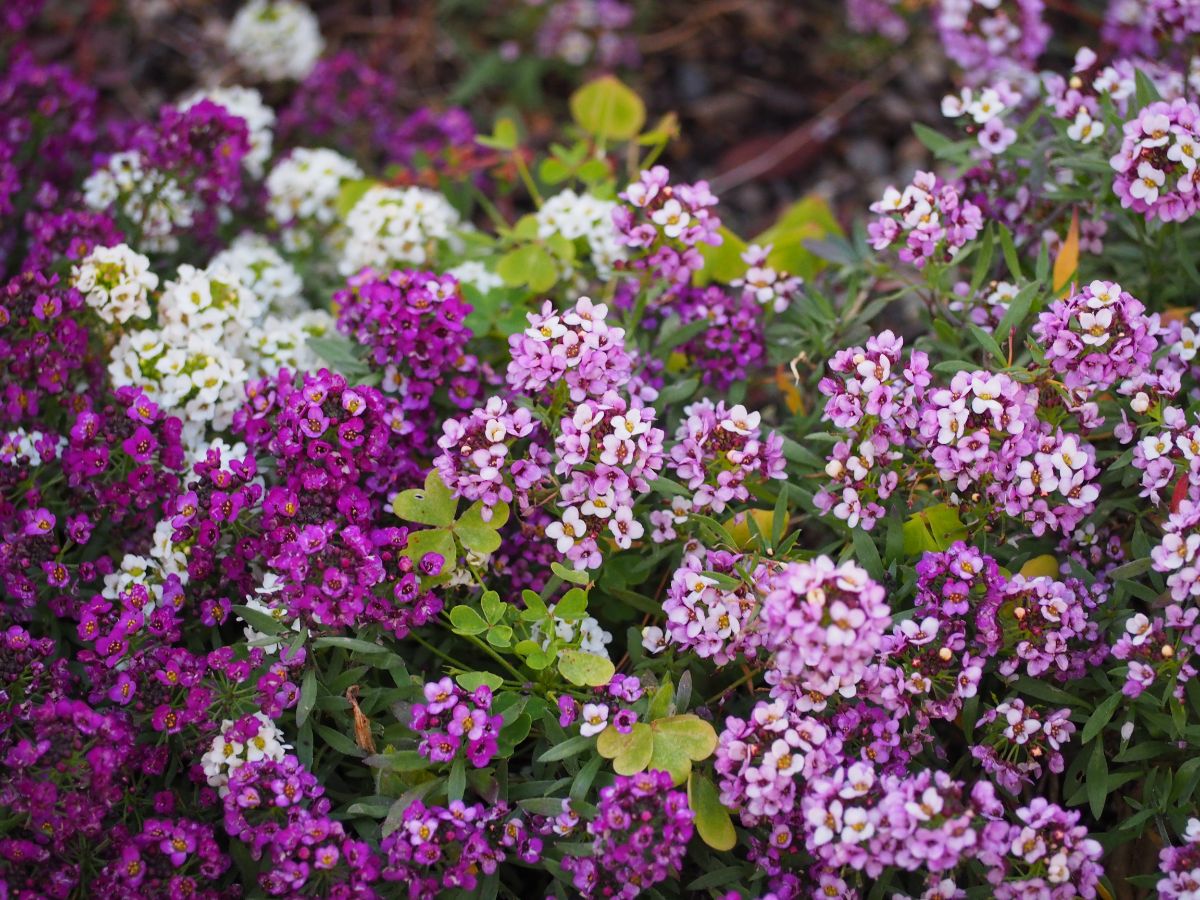
| Scientific Name: | Lobularia maritima |
| Other names: | alyssum, carpet flowe |
| Geographic Origin: | Europe |
| Plant Size: | 3-9” high and 6-12” width |
| Bloom Colors: | purple, white, and pink |
| Bloom Time: | fall and spring |
| Sun Exposure: | full or partial |
| Hardiness Zone: | 5-9 |
| Soil Type: | moist and well-drained |
Sweet Alyssum flowers are dainty florals easily paired with statement flowers to create bouquets. These flowers have a light fragrance that adds a delicate aroma to your flower bed or garden.
The flowers themselves are relatively small and grow in clusters. While lovely, these flowers are considered invasive in certain areas, like California. They are aggressive growers.
You can plant Alyssum in spring after the danger of late frosts is over. The flowers may fade in the summer heat but may bloom again in the fall. In areas where snow and frost are not a threat, Alyssum may be grown through the fall and winter.
2. Angelonia
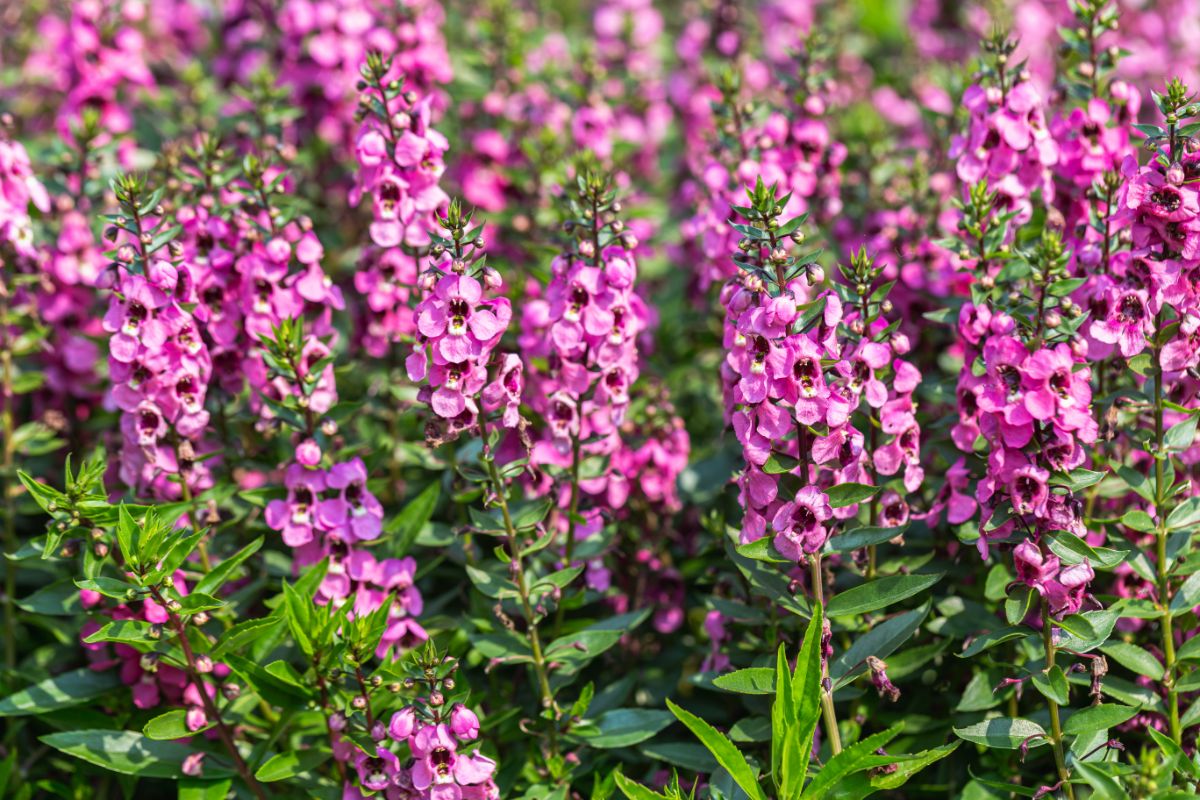
| Scientific Name: | Angelonia angustifolia |
| Other names: | summer snapdragon |
| Geographic Origin: | Mexico to Argentina |
| Plant Size: | 12-24 inches high |
| Bloom Colors: | pink, purple, and white |
| Bloom Time: | late spring through fall |
| Sun Exposure: | full sun |
| Hardiness Zone: | 8-11 |
| Soil Type: | well-drained |
The Angelonia flower produces hundreds of flowers throughout a growing season and is a favorite of hummingbirds and butterflies. Sometimes called the "summer snapdragon," it's not related. These plants grow well in containers and thrive in hot and sunny locations. The flowers have a cascading habit and look attractive over the edge of a container or in hanging baskets.
3. African Daisy
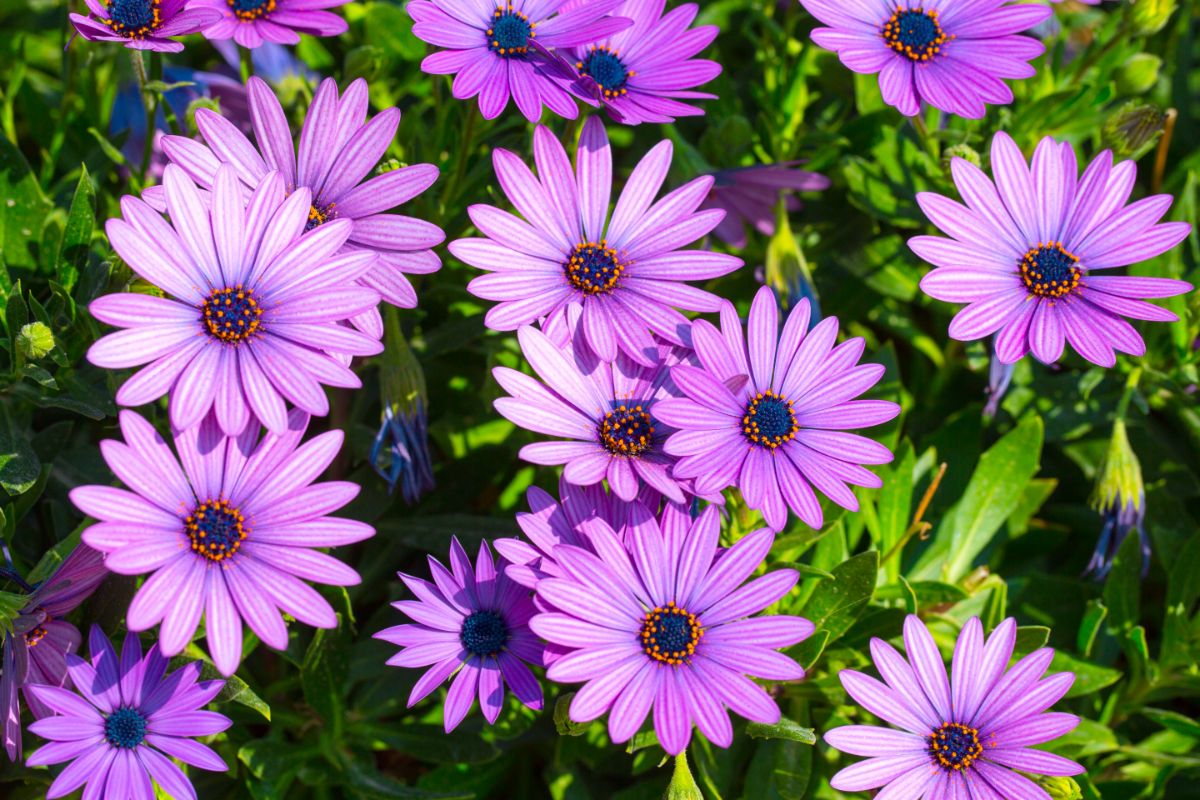
| Scientific Name: | Osteospermum |
| Other names: | blue-eyed daisy |
| Geographic Origin: | South Africa |
| Plant Size: | 12-36 inches high |
| Bloom Colors: | red, light orange, darker orange, yellow, lavender, violet, and white |
| Bloom Time: | late summer through early fall |
| Sun Exposure: | full sun |
| Hardiness Zone: | 9-11 |
| Soil Type: | well-drained |
The African daisy is a happy flower that blooms for an exceptionally long time. They add color to any bouquet and are beautiful standing alone.
4. Celosia
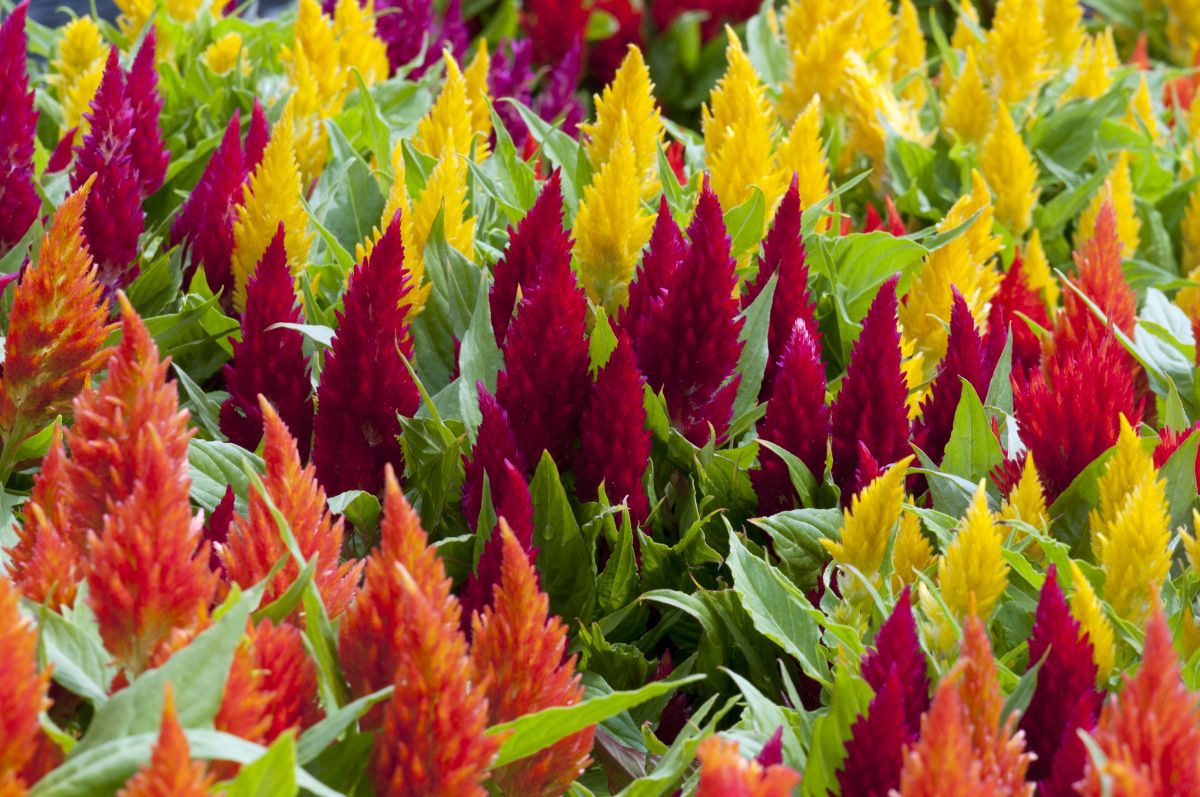
| Scientific Name: | Celosia argentea |
| Other names: | red fox, wallflower |
| Geographic Origin: | Africa and India |
| Plant Size: | 24-36 inches high |
| Bloom Colors: | yellow, orange, red, and magenta |
| Bloom Time: | late summer through fall |
| Sun Exposure: | full sun |
| Hardiness Zone: | 2-9 |
| Soil Type: | well-drained |
These wonderful annuals are easy to care for and come in many varieties, such as Century Mix and Dragon's Breath. Some varieties can grow quite large in the right climate, so they need places where there's room for them to expand. The flowers draw in many pollinators, especially bumblebees, and make excellent dried flowers.
5. Dianthus
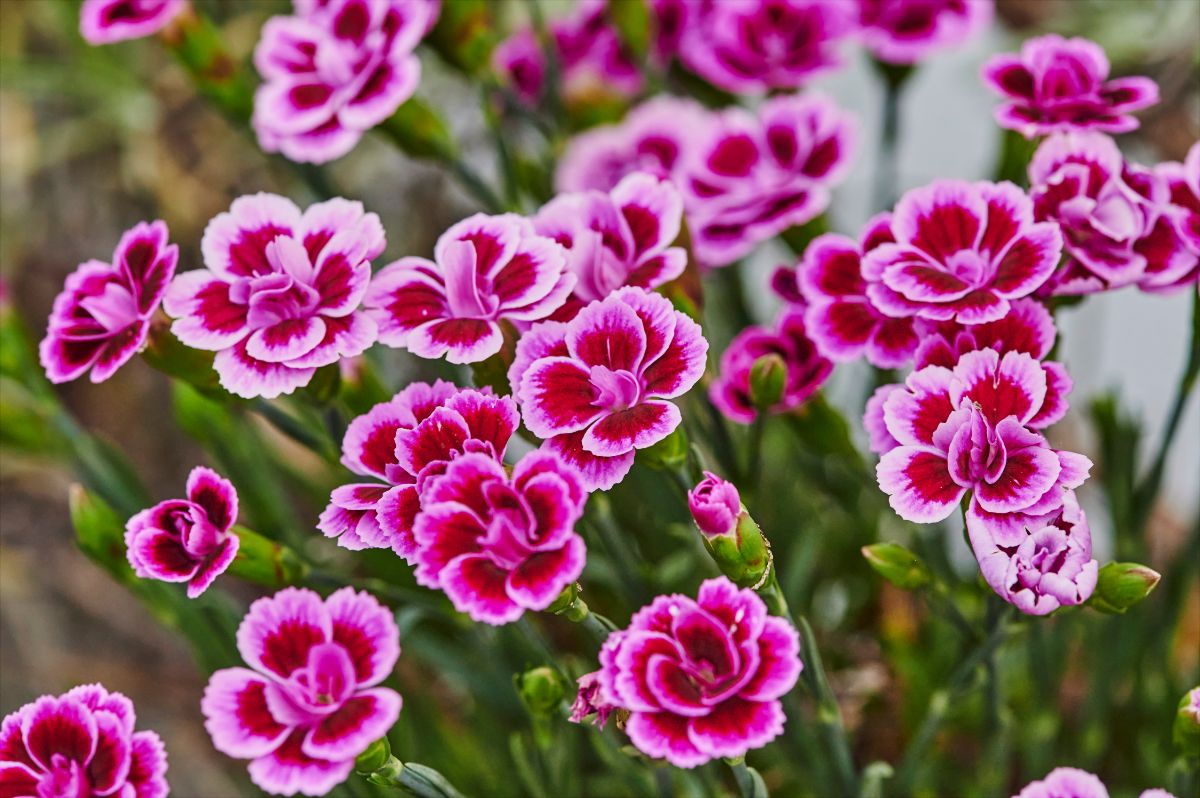
| Scientific Name: | Dianthus caryophyllus |
| Other names: | pinks |
| Geographic Origin: | Europe and Asia |
| Plant Size: | 6-12 inches high |
| Bloom Colors: | pink, magenta, or white |
| Bloom Time: | spring to early summer |
| Sun Exposure: | full sun/ partial shade |
| Hardiness Zone: | 3-9 |
| Soil Type: | well-drained |
The Dianthus flowers are exceptionally fragrant and sport beautiful bluish-green foliage. Flower lovers everywhere lovingly refer to these flowers as "pinks."
6. Garden Cosmos
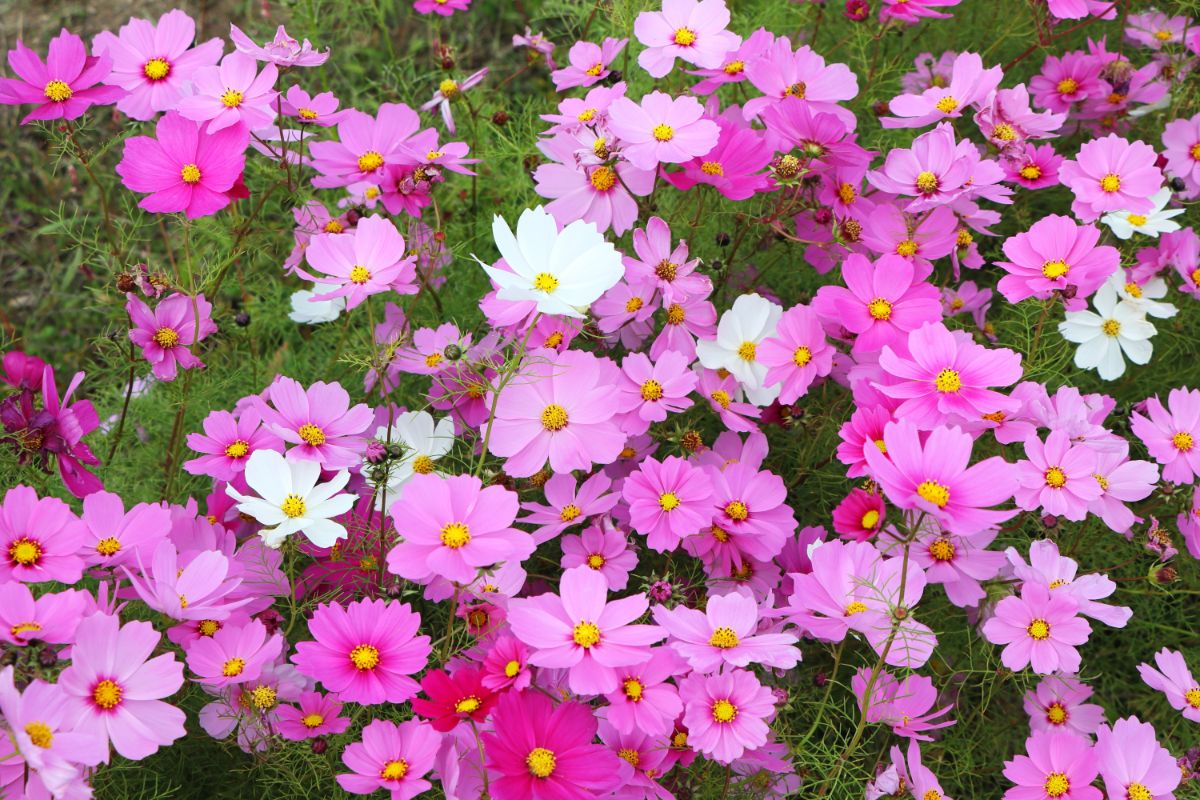
| Scientific Name: | Cosmos bipinnatus |
| Other names: | Mexican aster |
| Geographic Origin: | Mexico, Guatemala, Costa Rica |
| Plant Size: | 24-48 inches high |
| Bloom Colors: | pink, magenta, or white |
| Bloom Time: | midsummer until the first frost |
| Sun Exposure: | full sun |
| Hardiness Zone: | 2-11 |
| Soil Type: | well-drained |
These flowers are easy to grow from seed. You plant them in late spring. The "Sensation mix" and "Heirloom" variety have bright flower clusters.
7. Snapdragon

| Scientific Name: | Antirrhinum majus |
| Other names: | lions-snap, lions mouth |
| Geographic Origin: | Spain and Italy |
| Plant Size: | 12-36 inches high |
| Bloom Colors: | red, light orange, orange, yellow, purple, violet, and white |
| Bloom Time: | spring to fall |
| Sun Exposure: | full sun |
| Hardiness Zone: | 7-11 |
| Soil Type: | well-drained |
The blooms of the Snapdragon come in a wide variety of colors and shapes that make them ideal for adding to any type of bouquet. Snapdragons have a strong fragrance and exhibit mouth-like petals.
8. Geranium

| Scientific Name: | Geraniaceae |
| Other names: | cranesbill |
| Geographic Origin: | South Africa |
| Plant Size: | 12-28 inches high |
| Bloom Colors: | yellow, white, orange, pink, and red, and sometimes a reddish yellow |
| Bloom Time: | early to late spring through mid-summer |
| Sun Exposure: | full sun |
| Hardiness Zone: | 9-12 |
| Soil Type: | well-drained |
Geraniums flower through dry spells, heat, and even neglect. They can even persevere through long hot summers. You want to fertilize these flowers with an all-purpose fertilizer in time frames from 2 to 4 weeks.
9. Flowering Kale

| Scientific Name: | Brassica oleracea |
| Other names: | ornamental cabbage |
| Geographic Origin: | Mediterranean, Asia |
| Plant Size: | 12-15 inches high |
| Bloom Colors: | purple, green, and white |
| Bloom Time: | spring to fall |
| Sun Exposure: | full sun/ partial shade |
| Hardiness Zone: | 2-11 |
| Soil Type: | well-drained |
Flowering kale is not edible, and it doesn't taste good, but it has relatively large and beautiful leaves. This flower has the best color and flourishes in cooler weather conditions.
10. Latana
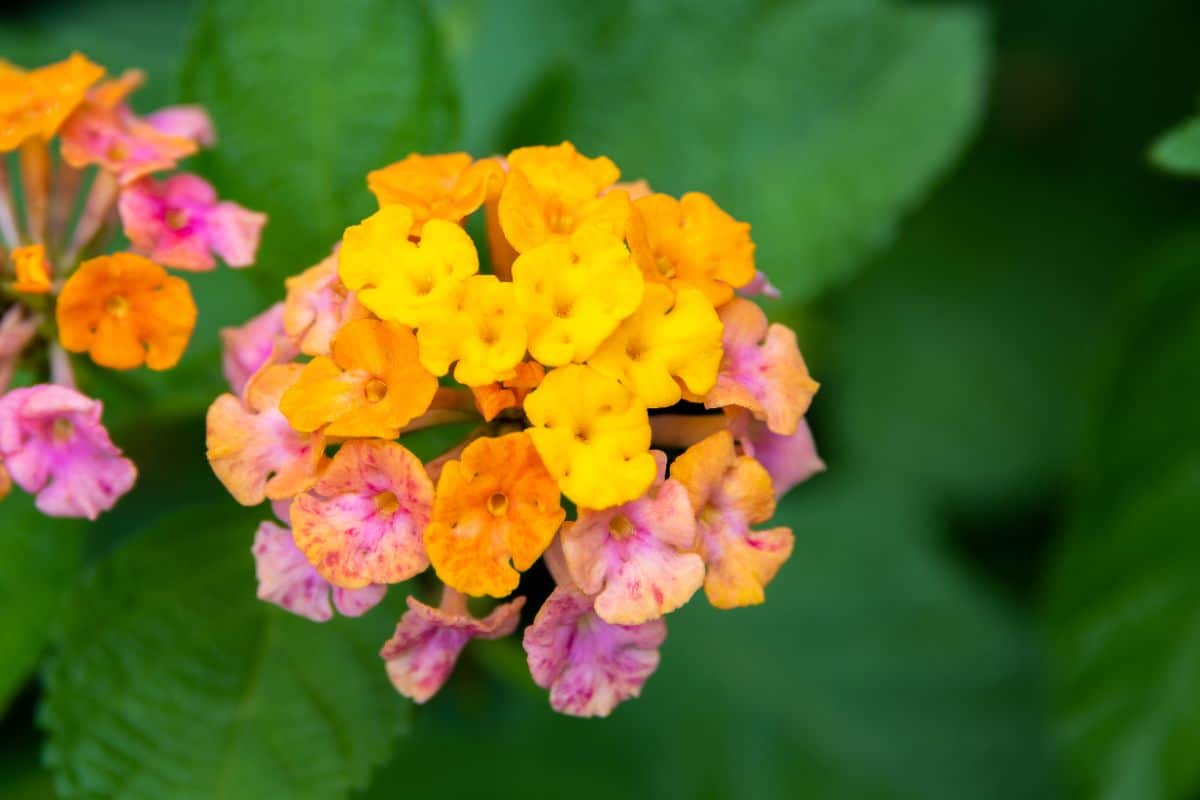
| Scientific Name: | Lantana camera |
| Other names: | shrub verbenas, latanas |
| Geographic Origin: | America and Africa |
| Plant Size: | 12-18 inches high |
| Bloom Colors: | orange, white, red, yellow, and pink |
| Bloom Time: | early summer up to the first frost |
| Sun Exposure: | full sun |
| Hardiness Zone: | 9-11 |
| Soil Type: | well-drained |
This flower has nectar-rich clusters and is a hummingbird and butterfly magnet. Latana are heat tolerant and drought resistant. In warmer winter climates, this flower acts as a shrubby perennial plant.
11. Sweet Pea

| Scientific Name: | Lathyrus odoratus |
| Other names: | bird of paradise, alfalfa |
| Geographic Origin: | Italy |
| Plant Size: | 2-10 feet high |
| Bloom Colors: | white, pink, and reddish-violet |
| Bloom Time: | spring and summer |
| Sun Exposure: | full sun |
| Hardiness Zone: | 7-10 |
| Soil Type: | well-drained |
The flowers from the Sweet Pea are ingredients in the manufacture of perfume because of their delicate and sweet scent.
12. Marigold
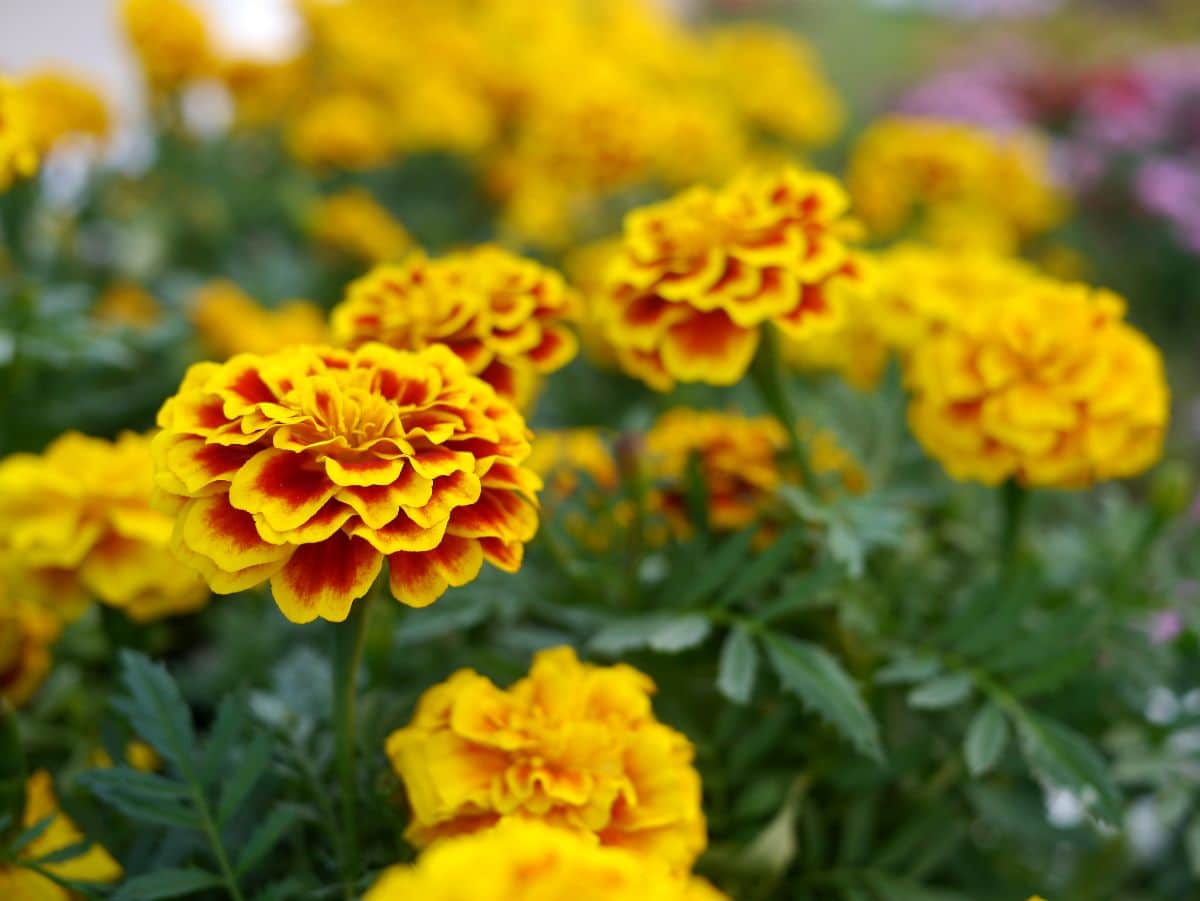
| Scientific Name: | Tagetes erecta |
| Other names: | candytuft |
| Geographic Origin: | Mexico, Guatemala |
| Plant Size: | 6-24 inches high |
| Bloom Colors: | orange, yellow, and red |
| Bloom Time: | early summer until late frost |
| Sun Exposure: | full sun |
| Hardiness Zone: | 2-11 |
| Soil Type: | well-drained |
The marigold is easy to start from seed and is a cinch to find as transplants in garden centers. These flowers produce cheery and sunny pom-pom-shaped flowers. These hardy flowers have excellent humidity and heat tolerance and are resistant to deer.
13. Flowering Stock
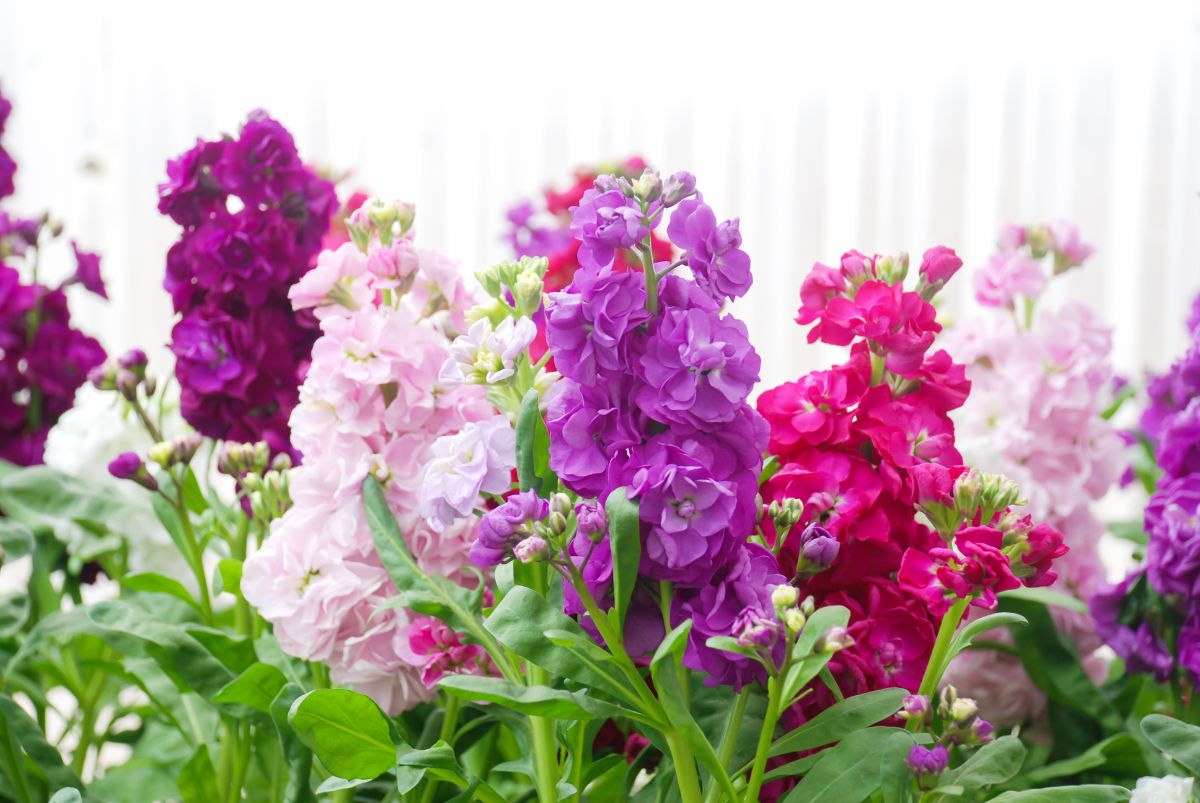
| Scientific Name: | Matthiola incana |
| Other names: | gillyflowers |
| Geographic Origin: | Eurasia, Southern Africa |
| Plant Size: | 12-24 inches high |
| Bloom Colors: | red, yellow, light blue, white, purple, and pink |
| Bloom Time: | late spring |
| Sun Exposure: | full sun |
| Hardiness Zone: | 2-10 |
| Soil Type: | moist and well-drained |
The Flowering Stock has a clove-like aroma, making it ideal for bouquets or lining specific areas of your garden or lawn.
14. Mealycup Sage
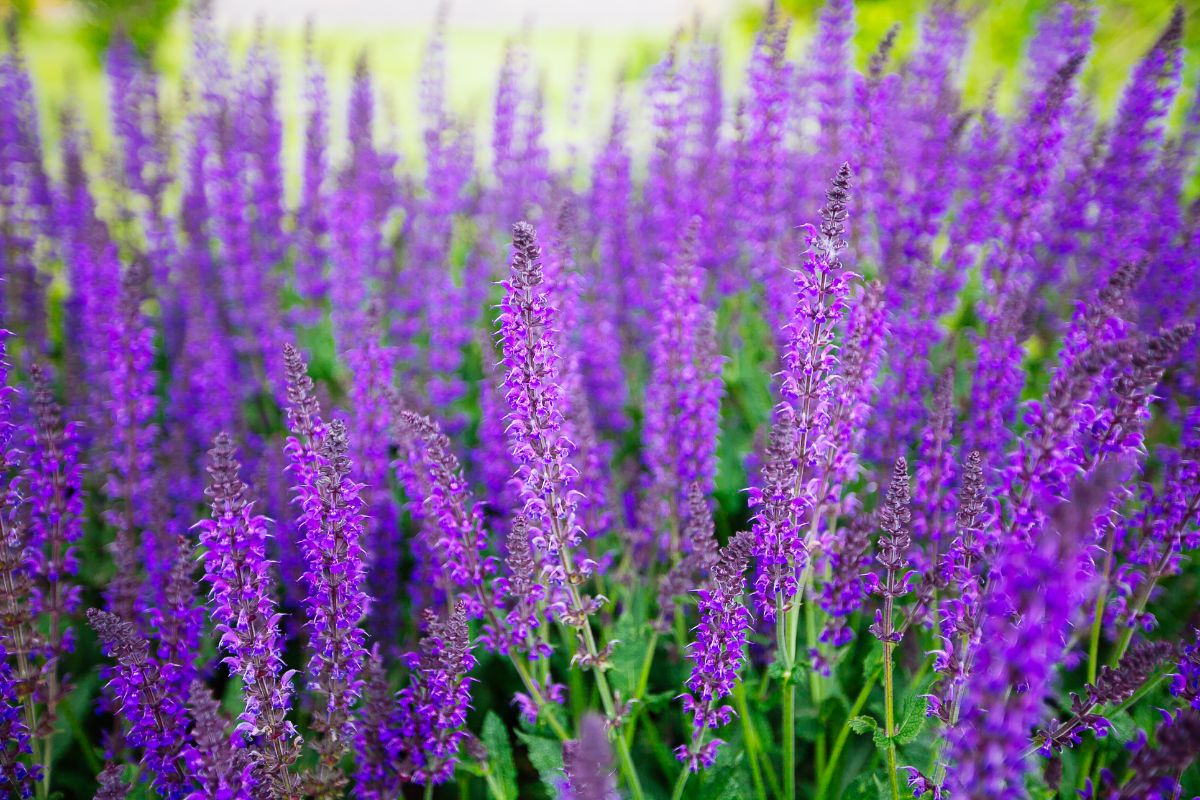
| Scientific Name: | Salvia farinacea |
| Other names: | mealy sage, blue sage |
| Geographic Origin: | America, Mexico |
| Plant Size: | 12-24 inches high |
| Bloom Colors: | purple |
| Bloom Time: | early summer to late frost |
| Sun Exposure: | full sun to partial shade |
| Hardiness Zone: | 7-10 |
| Soil Type: | moist, well-drained |
The easiest way to plant Mealycup Sage is from transplants purchased at garden centers. This flower is an excellent vertical accent for gardens and will grow fast. If you snip off the flowers in July, the plant will quickly produce another round of flower spikes.
15. English Primrose
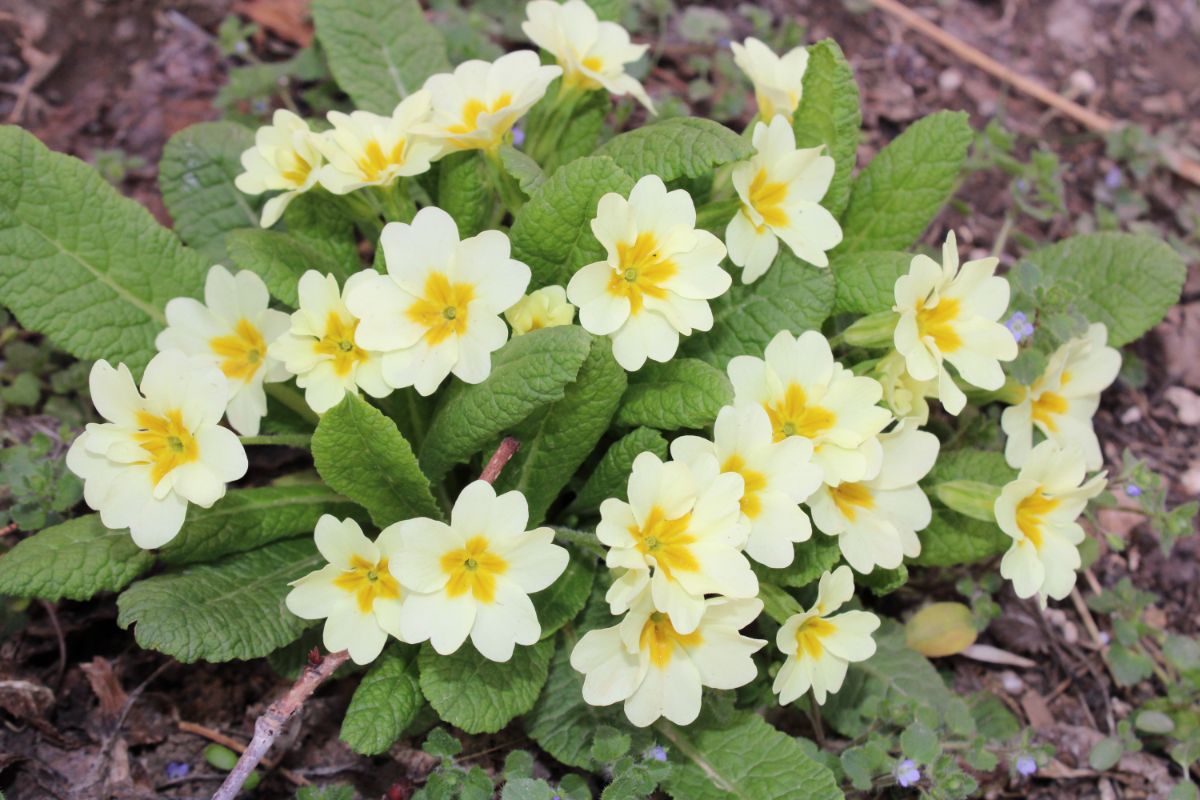
| Scientific Name: | Primula vulgaris |
| Other names: | evening star, sundrop |
| Geographic Origin: | Europe, Africa, Asia |
| Plant Size: | 6-20 inches high |
| Bloom Colors: | red, white, orange, yellow, light blue, purple, pink, and white |
| Bloom Time: | late winter, early spring, late spring, depending on the type |
| Sun Exposure: | partial shade |
| Hardiness Zone: | 4-8 |
| Soil Type: | well-drained |
The most popular variety of annual is the English Primrose. However, this late-blooming winter favorite usually has a short lifespan. This wonderful flower comes in brilliant colors that brighten any environment during the gloomy winter season.
16. Pentas
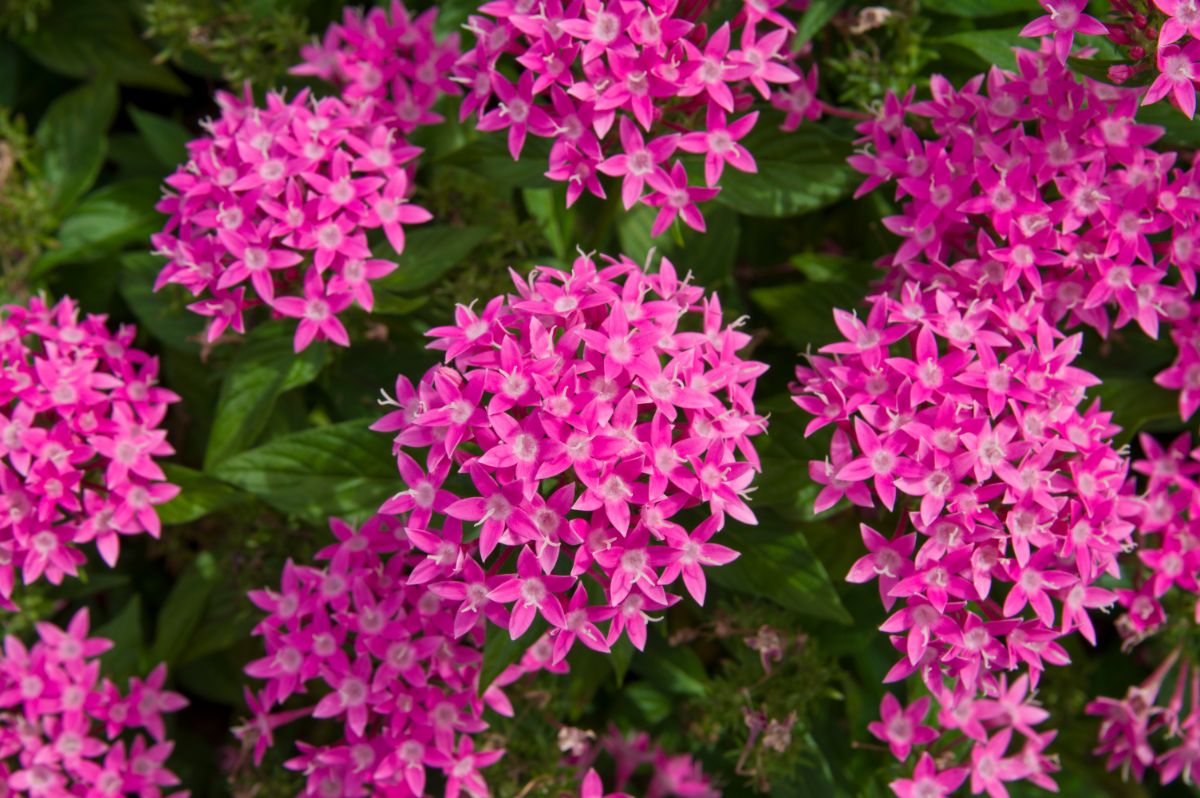
| Scientific Name: | Pentas lanceolata |
| Other names: | Egyptian stars, starflower |
| Geographic Origin: | Southern Africa, Comoros, Madagascar, the Arabian peninsula |
| Plant Size: | 12-24 inches high |
| Bloom Colors: | pink, red, and white |
| Bloom Time: | summer |
| Sun Exposure: | full sun |
| Hardiness Zone: | 10-11 |
| Soil Type: | moist and well-drained |
This annual flower has large clusters of star-shaped flowers. These flowers are very popular with pollinators, and they have a lot of nectar.
The Pentas tolerates heat and humidity very well and works well as filler in containers or grouped with several other plants together in garden beds for splashes of color.
17. Calendula
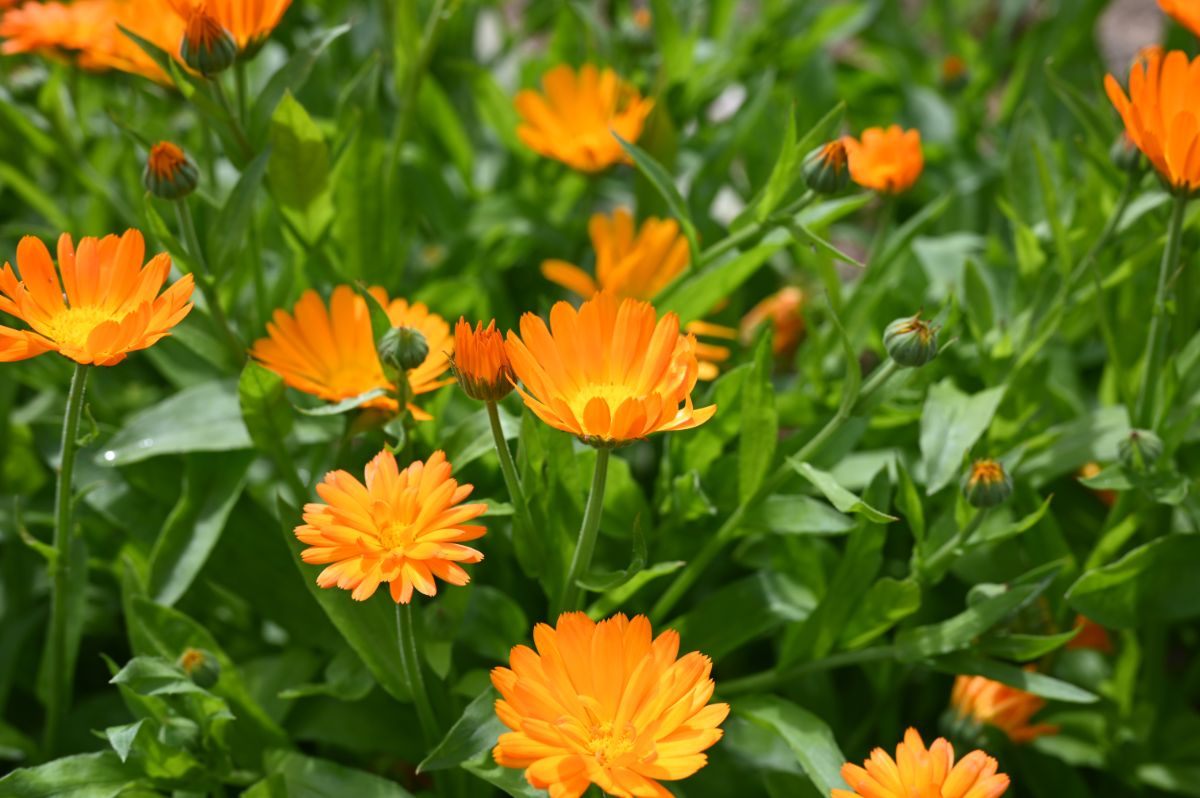
| Scientific Name: | Calendula offiicinalis |
| Other names: | pot marigold |
| Geographic Origin: | Eurasia, Southern Africa |
| Plant Size: | 12-24 inches high |
| Bloom Colors: | early summer until the first frost |
| Bloom Time: | spring to early fall |
| Sun Exposure: | full sun/ partial shade |
| Hardiness Zone: | 2-11 |
| Soil Type: | well-drained |
This flower is a tasty treat as it is edible and is popular in soups and salads. Other uses for Calendula include essential oils to help hydrate and heal the skin.
18. Petunia

| Scientific Name: | Petunia atkinsania |
| Other names: | petal, posy |
| Geographic Origin: | South America |
| Plant Size: | 10-12 inches high |
| Bloom Colors: | pink, purple, white, red, or yellow |
| Bloom Time: | early summer until the first frost |
| Sun Exposure: | full sun |
| Hardiness Zone: | 9-11 |
| Soil Type: | well-drained |
You can use petunias to make a carpet of blooms in garden beds or hanging, cascading over the edges of containers or hanging baskets. The blossoms of the Petunia are trumpet-shaped.
19. Nasturtium
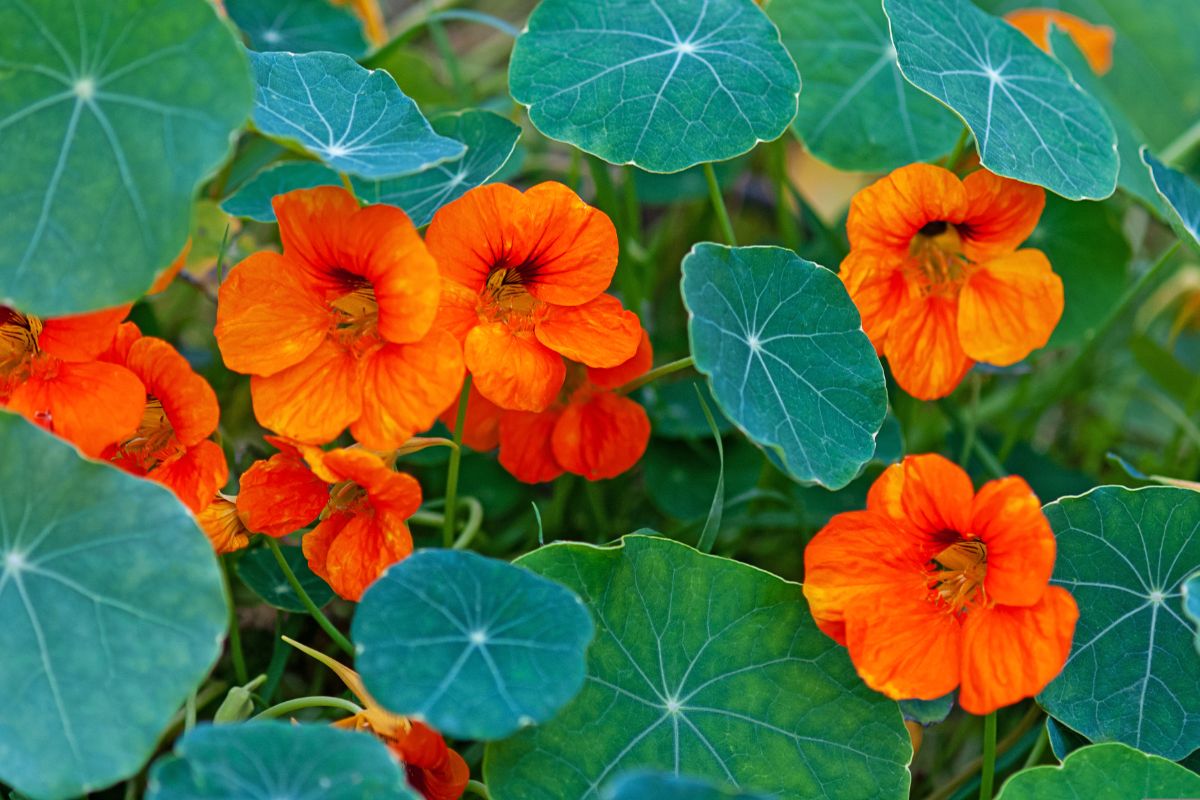
| Scientific Name: | Trapaelum majus |
| Other names: | indian cress, capucine |
| Geographic Origin: | Mexico, Central America, South America |
| Plant Size: | 1 to 10 feet high |
| Bloom Colors: | red, white, light orange, orange, yellow, purple, violet, and white |
| Bloom Time: | spring to fall |
| Sun Exposure: | full sun |
| Hardiness Zone: | 9-11 |
| Soil Type: | well-drained |
The Nasturtium flower makes a perfect gift in bouquets and other arrangements for the home or office and is a very popular plant.
20. Annual Vinca
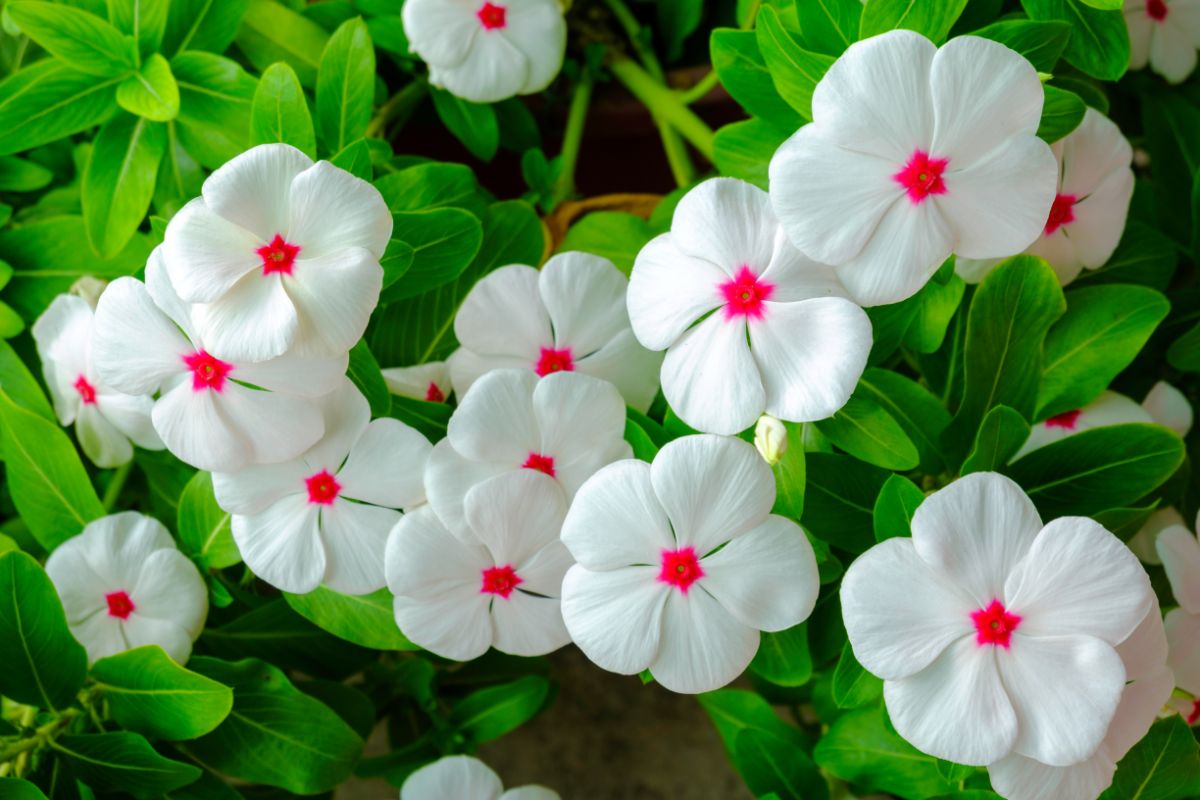
| Scientific Name: | Catharanthus |
| Other names: | Madagascar periwinkle |
| Geographic Origin: | Europe, Northern Africa |
| Plant Size: | 12 to 18 inches high |
| Bloom Colors: | lavender, red, pink, and white |
| Bloom Time: | early summer to the first frost |
| Sun Exposure: | full sun/ partial shade |
| Hardiness Zone: | 10 |
| Soil Type: | well-drained |
The Vinca sports glossy green foliage that accents its pinwheel-shaped flowers. There are upright growing varieties and trailing varieties of Vinca. This plant grows best in full sun to partial shade in well-drained soil conditions and grows from 1 ft tall to 1 to 2 ft wide.
21. Begonia
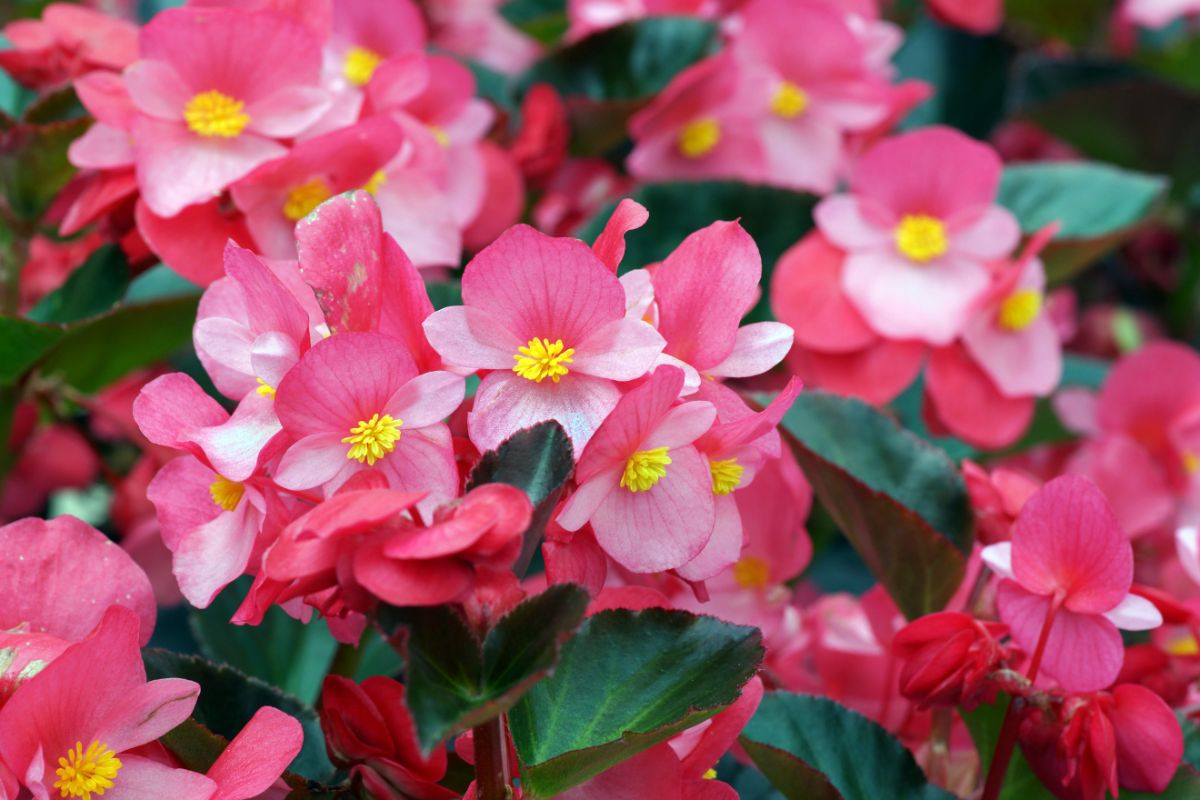
| Scientific Name: | Begonia |
| Other names: | hebes, gladiola |
| Geographic Origin: | Brazil, Mexico |
| Plant Size: | 8 inches to 3 feet high |
| Bloom Colors: | scarlet, light orange, pink, medium orange, violet, and white |
| Bloom Time: | summer, fall |
| Sun Exposure: | full sun/partial shade |
| Hardiness Zone: | 8-10 |
| Soil Type: | well-drained |
Many people favor Begonia, thanks to its big blooms. The Begonia also comes in many colors and pairs well in bouquets or gardens.
22. Zinnia
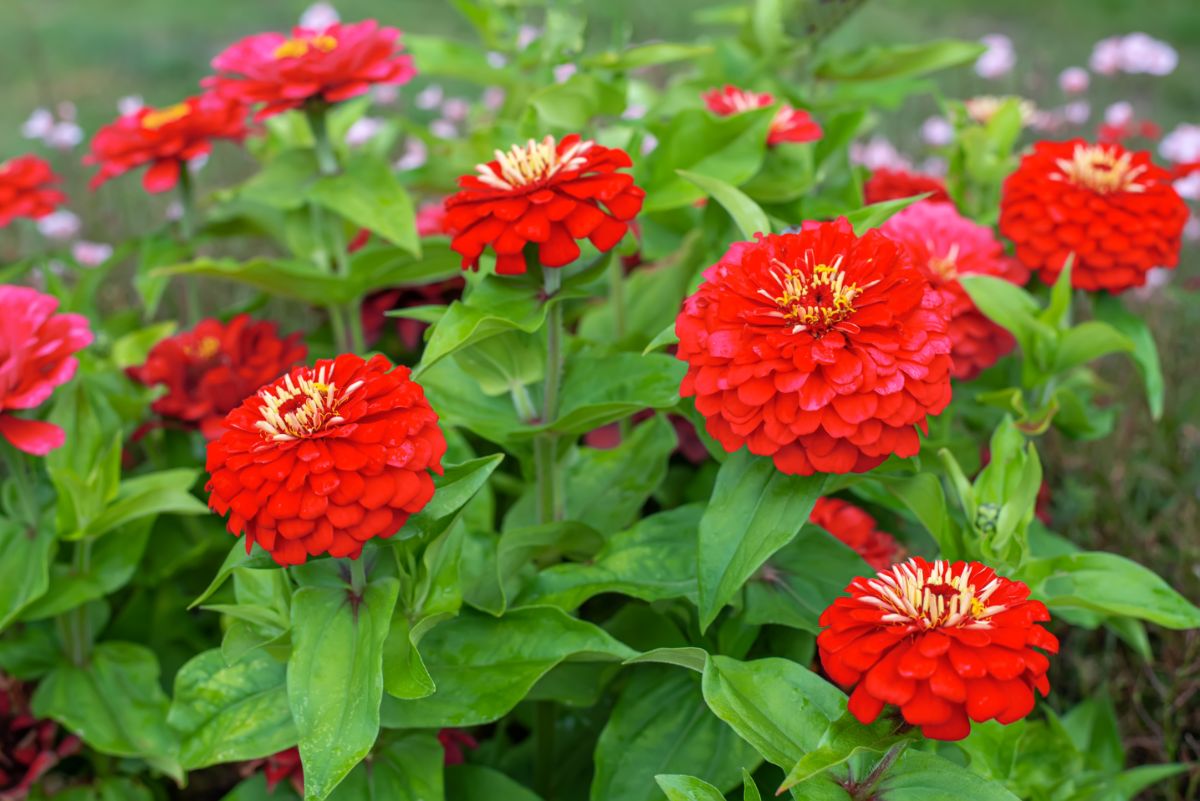
| Scientific Name: | Zinnia elegans |
| Other names: | zeezee, nini |
| Geographic Origin: | Mexico, Central America |
| Plant Size: | 2-6 inches high |
| Bloom Colors: | pink, red, yellow, orange, purple, white, lavender, green |
| Bloom Time: | midsummer to fall |
| Sun Exposure: | full sun |
| Hardiness Zone: | 2-8 |
| Soil Type: | well-drained |
This annual flower starts easily from seeds, and it will yield copious amounts of daisy-like flower blooms from midsummer until fall. You should plant Zinnia flowers in your garden as soon as the frost passes.
23. Cornflower
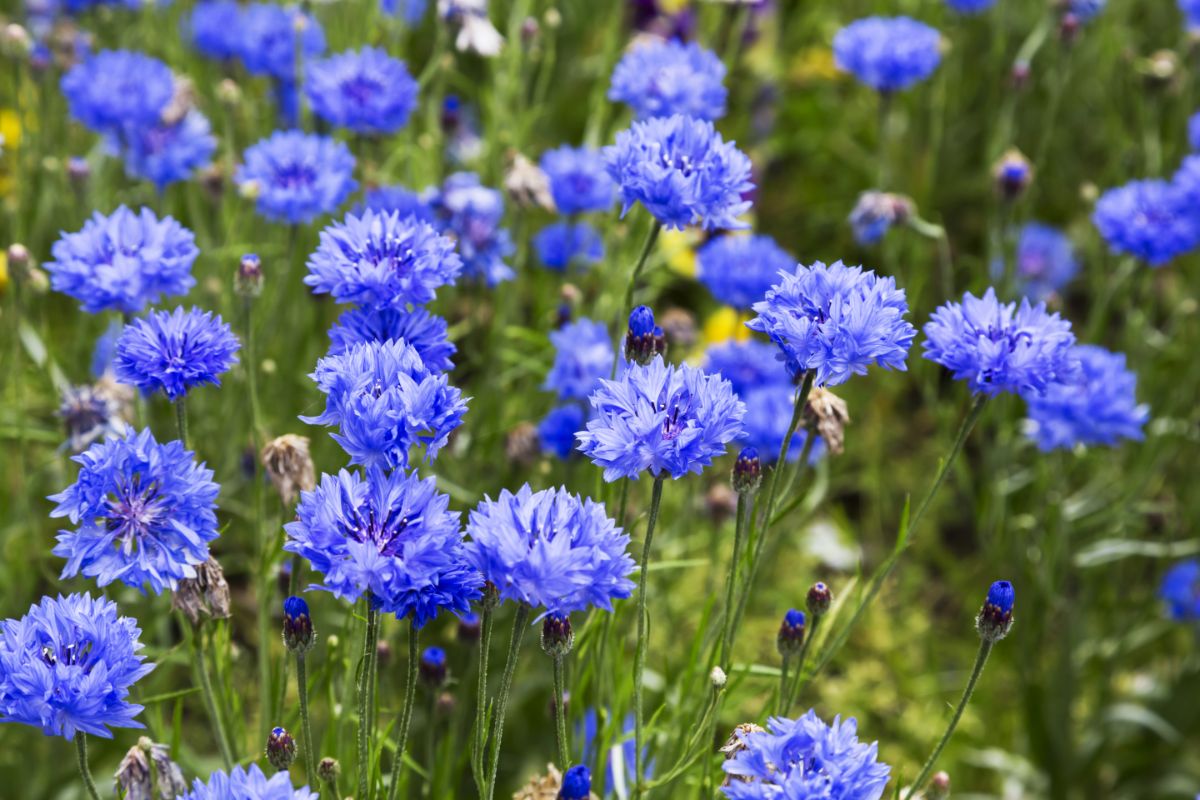
| Scientific Name: | Centaurea cyanus |
| Other names: | bachelor’s button |
| Geographic Origin: | Europe |
| Plant Size: | 1-3 inches high |
| Bloom Colors: | blue, purplish red, violet, and white |
| Bloom Time: | spring to summer |
| Sun Exposure: | full sun |
| Hardiness Zone: | 2-11 |
| Soil Type: | well-drained |
The Cornflower has blooms that go by the name of bachelor's buttons and are a traditional blue color, usually. Cornflower flowers have a clove-like taste, and you can eat them as a garnish for meals.
24. Impatiens
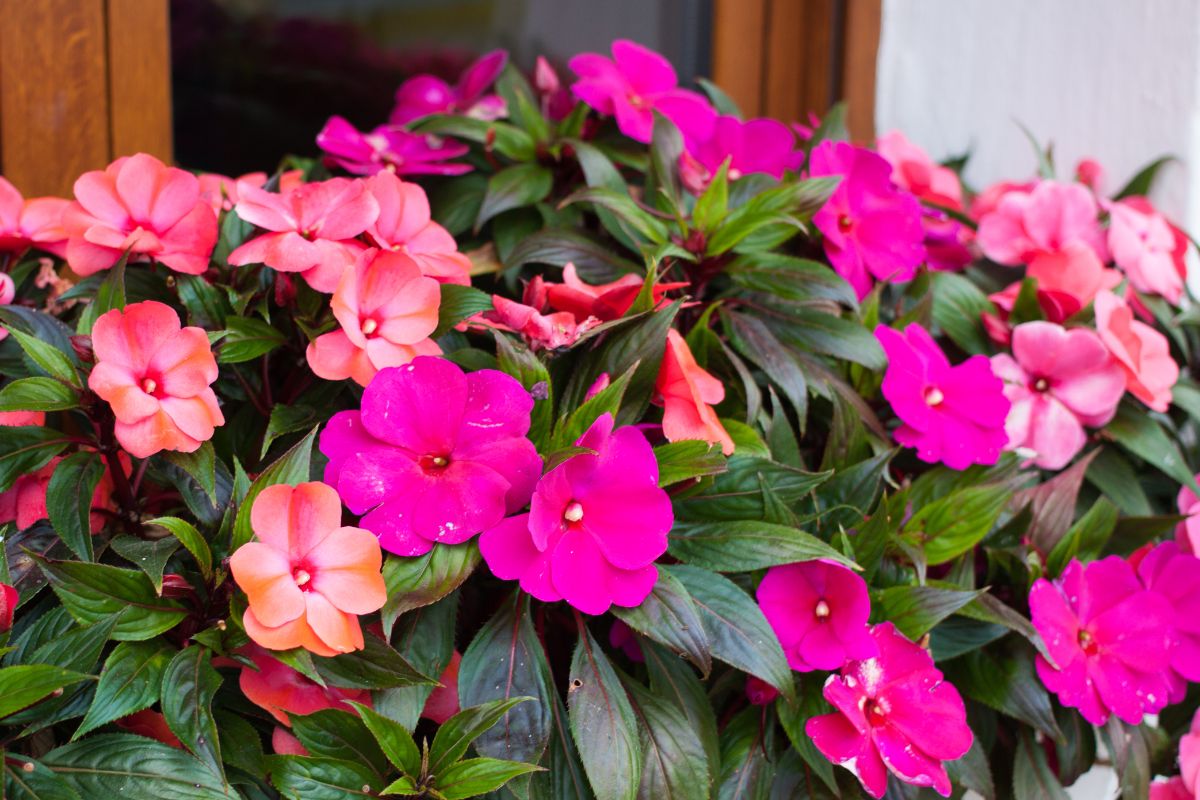
| Scientific Name: | Impatiens walleriana |
| Other names: | busy Lizzie, patient Lucy |
| Geographic Origin: | Asia |
| Plant Size: | 10-16 inches high |
| Bloom Colors: | red, orange, yellow, light blue, purple, pink, and white |
| Bloom Time: | spring, summer |
| Sun Exposure: | partial to full shade |
| Hardiness Zone: | 8-10 |
| Soil Type: | well-drained |
The Impatiens flower make excellent container plants, and many know them to be easy to grow. They are also called "busy Lizzy's" in England, and people in the US call them "patient Lucy."
25. Pansy
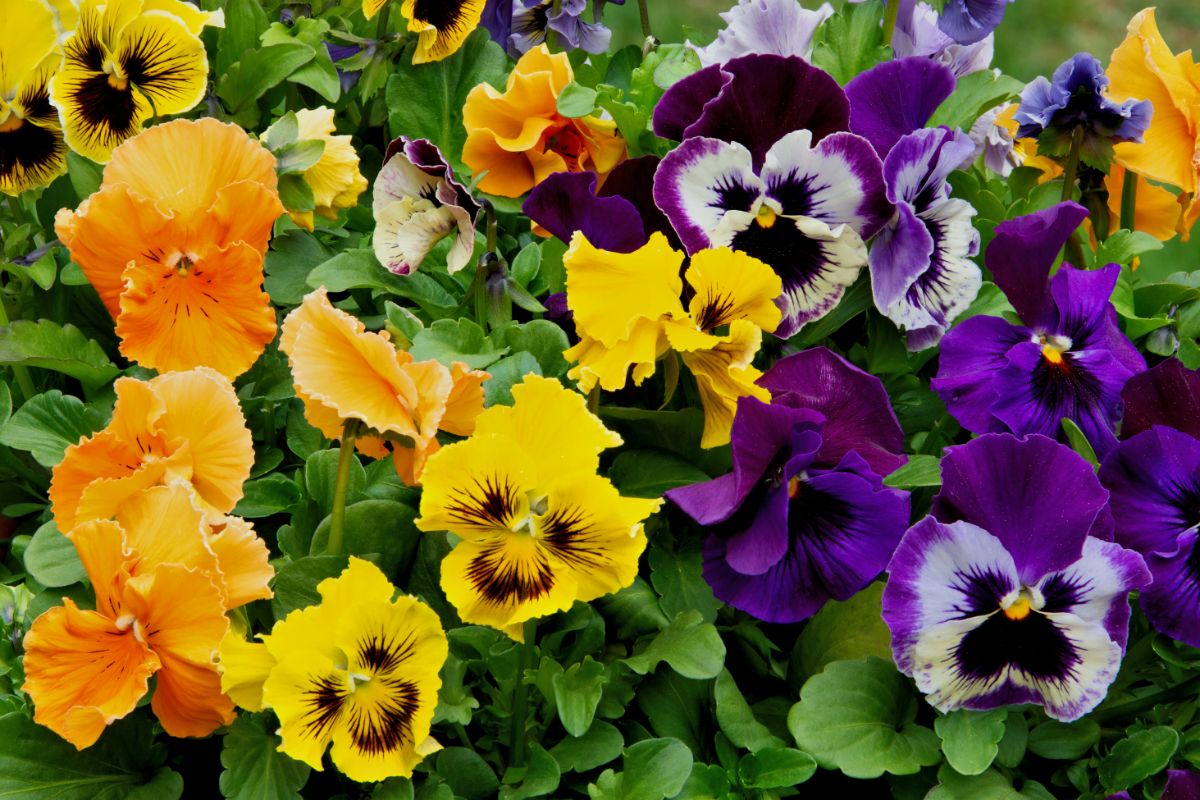
| Scientific Name: | Hortensis |
| Other names: | faces under the hood, heartsease |
| Geographic Origin: | England |
| Plant Size: | 6-9 inches high |
| Bloom Colors: | myriad colors (red, black, white, and yellow, to name a few) |
| Bloom Time: | spring to summer |
| Sun Exposure: | full sun |
| Hardiness Zone: | 7-10 |
| Soil Type: | well-drained |
Pansies are the most popular flower, hands down. These plants are perfect for beginning gardeners, as they offer simple rewards and offer a long season of colorful blooms. You can choose a white pansy for winter, a black pansy for drama, a red pansy for autumn, or a yellow pansy for fragrance.
26. Poppy
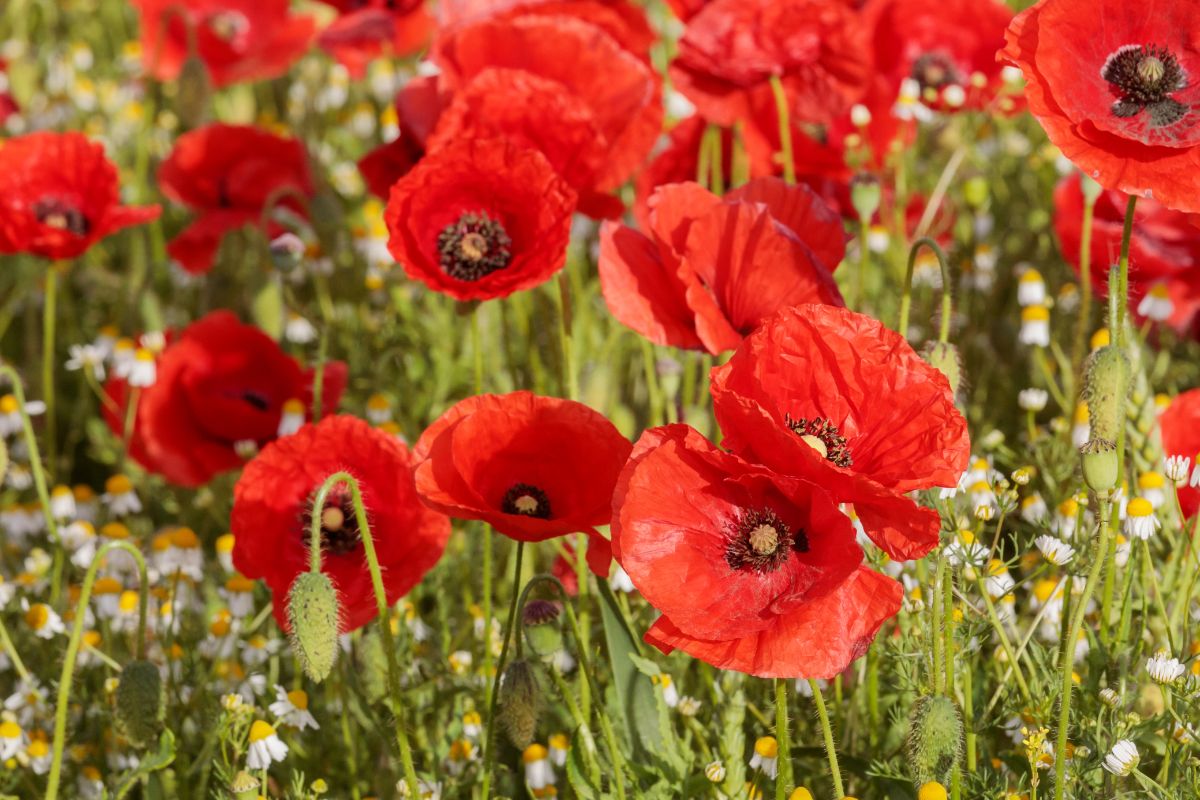
| Scientific Name: | Papaver rhoeas |
| Other names: | Flanders poppy, field poppy, common poppy |
| Geographic Origin: | Asia, Europe, North Africa |
| Plant Size: | 9-18 inches high |
| Bloom Colors: | red, orange, white, pink, yellow, and purple |
| Bloom Time: | summer to early fall |
| Sun Exposure: | full sun |
| Hardiness Zone: | 3-10 |
| Soil Type: | moist loamy |
Poppies are very popular, and there are a lot of different species. Here we are considering just the common poppy. Still, you may also be familiar with P. somniferum, the opium poppy, P. orientalis, aka the Oriental poppy, and E. californica, aka the California poppy.
Keep an eye on blooming times before purchasing either seeds or potted plants because some poppies have different blooming seasons. Poppies are an excellent choice if you have containers you want to fill in your balcony or yard, as they grow well in pots.
27. Calibrachoas
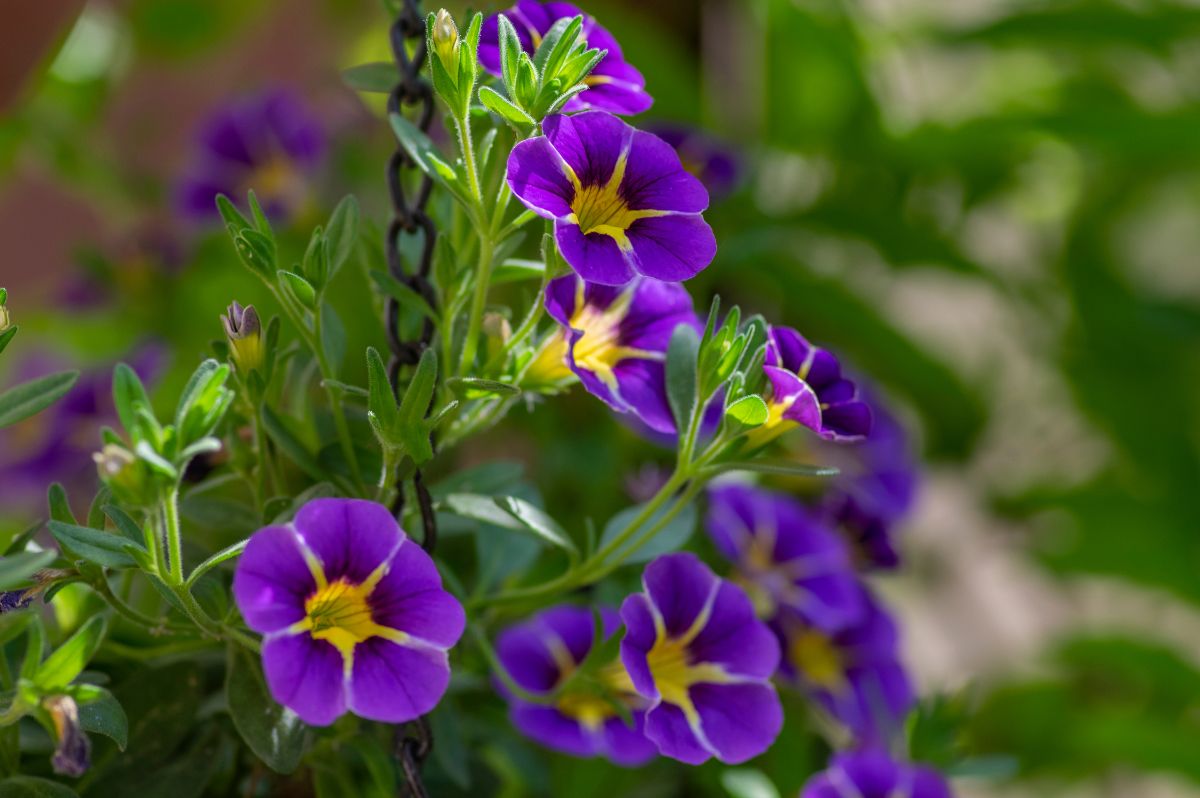
| Scientific Name: | Calibrachoas parviflora |
| Other names: | cabaret, colorburst, can-can |
| Geographic Origin: | America, Mexico, South América |
| Plant Size: | 8-10 inches high |
| Bloom Colors: | purple, orange, blue, red, white, pink, or yellow |
| Bloom Time: | spring to fall |
| Sun Exposure: | full sun/ partial shade |
| Hardiness Zone: | 9-11 |
| Soil Type: | fast-draining |
People often use this plant to show off their gardening skills. They work well in the garden bed or hanging baskets, planters, or window boxes. The flowers look like miniature petunias, and you can also choose a striped hybrid if you want to get creative. You can plant these flowers in small patches for ground cover.
28. Ageratum
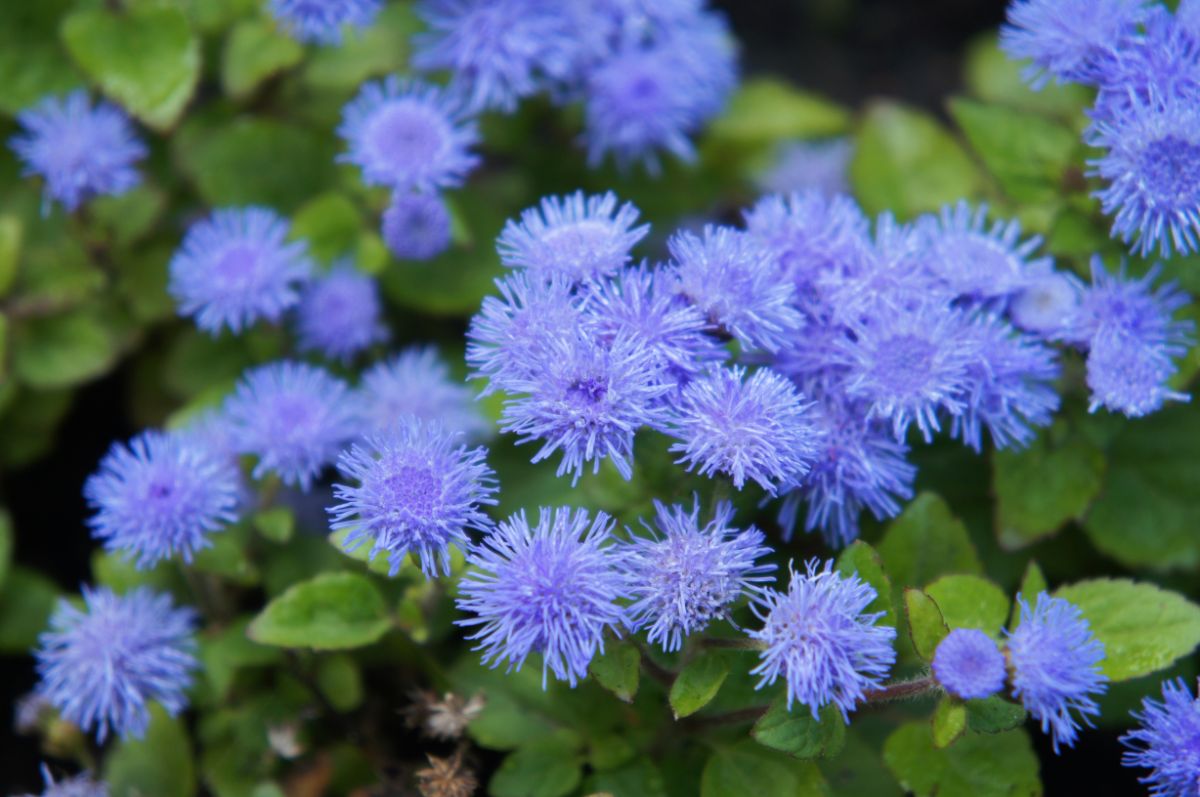
| Scientific Name: | Ageratum houstonianum |
| Other names: | pussyfoot, blueweed |
| Geographic Origin: | Mexico, South America |
| Plant Size: | 4-26 inches high |
| Bloom Colors: | white, violet, blue, or pink |
| Bloom Time: | late spring through fall |
| Sun Exposure: | full sun/ light shade |
| Hardiness Zone: | 7-10 |
| Soil Type: | well-drained |
Ageratums are often used as bedding plants, and the pom-pom shaped blossoms are a rarity in the gardening world. They mainly come in shades of blue, though you may find colors ranging from pink to lavender, or even red.
The flowers attract pollinators such as bees, hummingbirds, and butterflies, making them a beautiful addition and pollinator-friendly option in your garden.

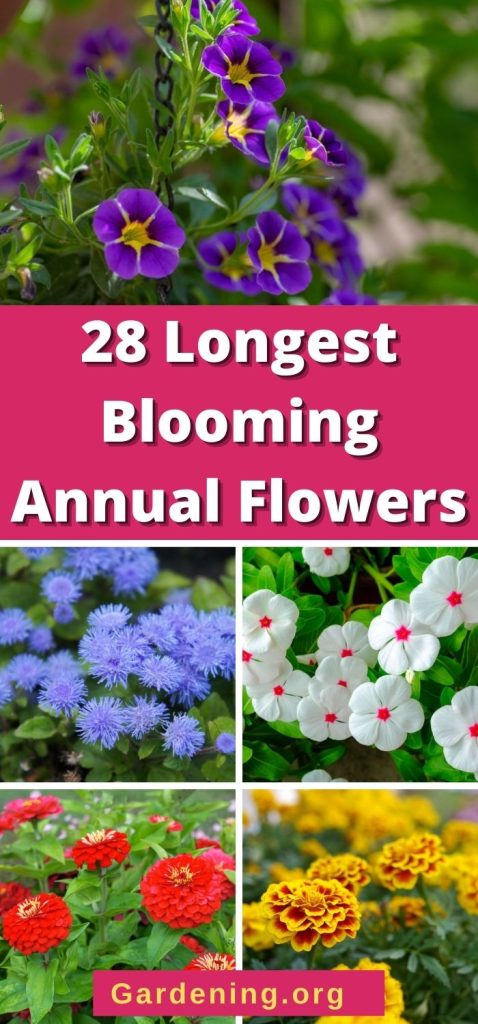
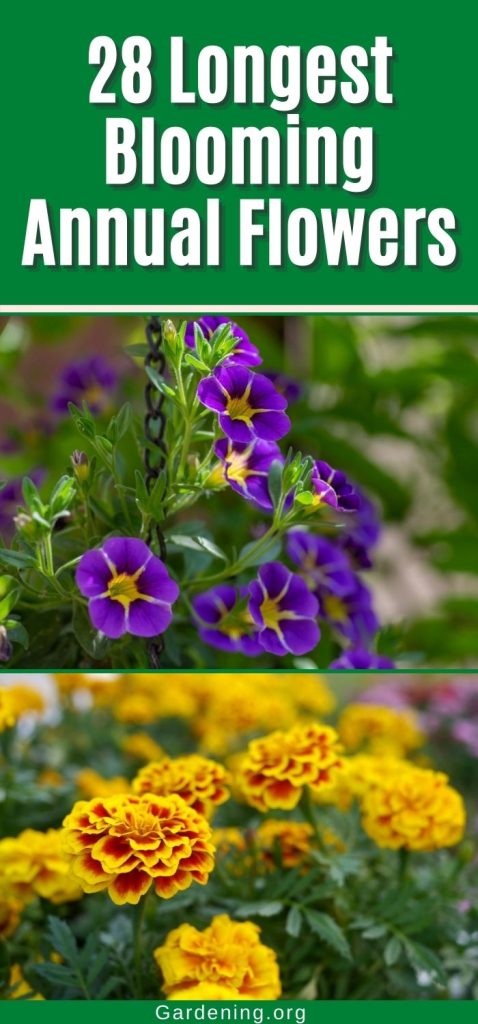
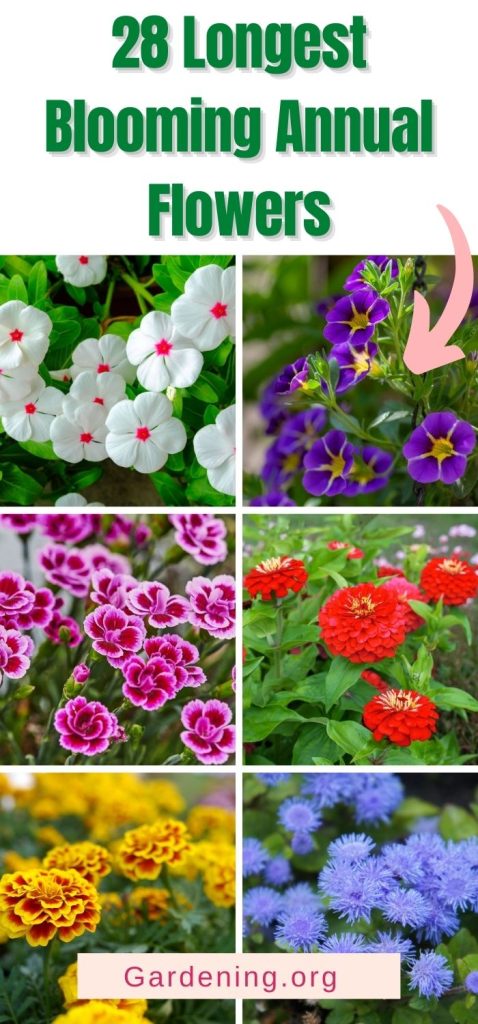
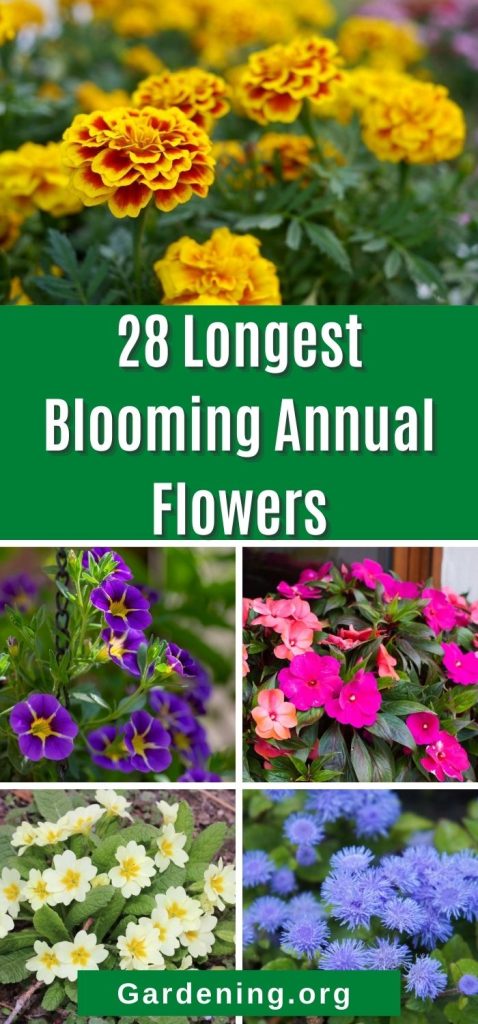

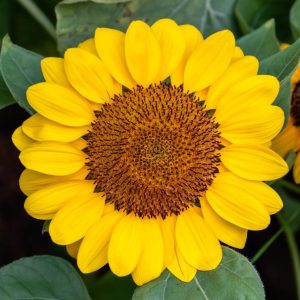
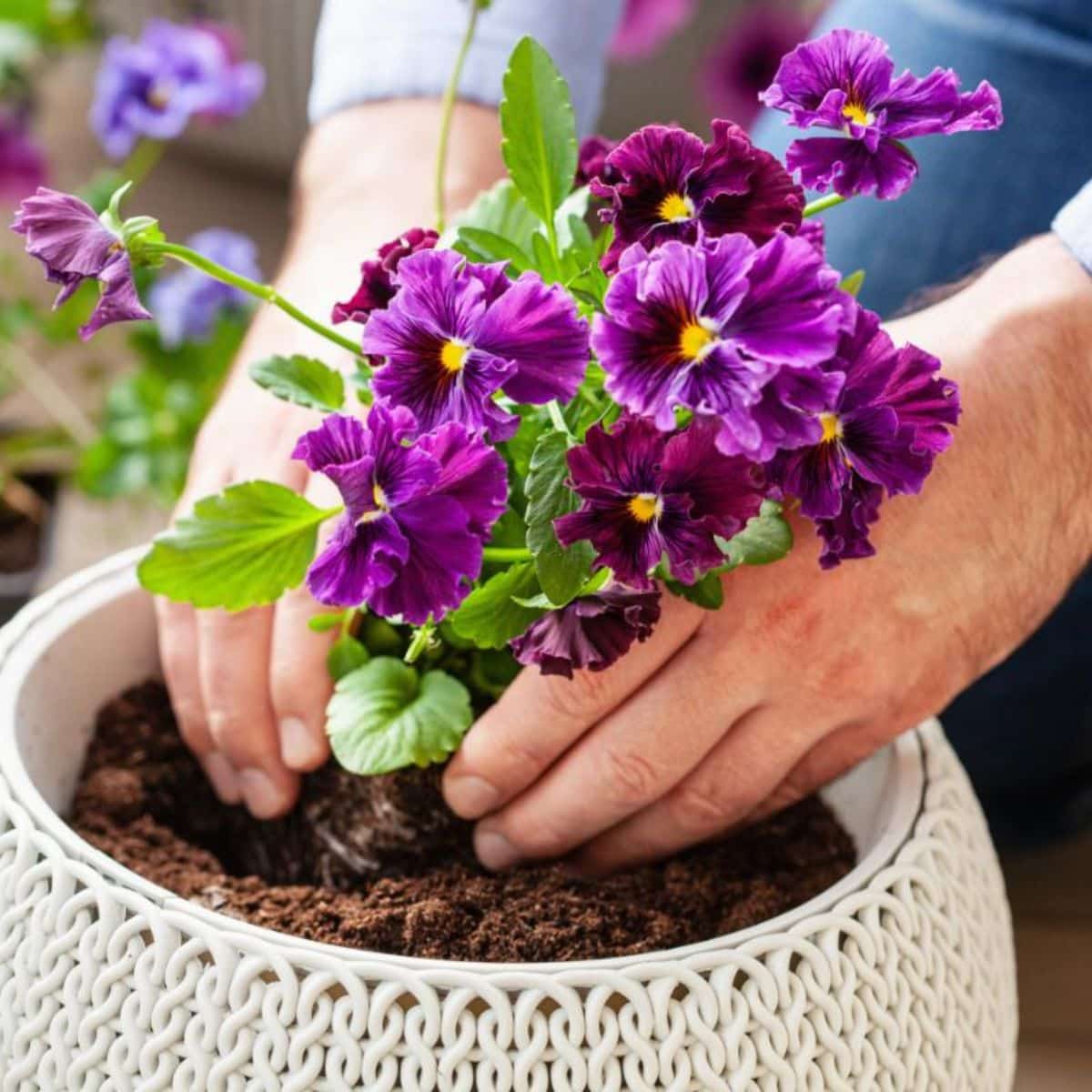
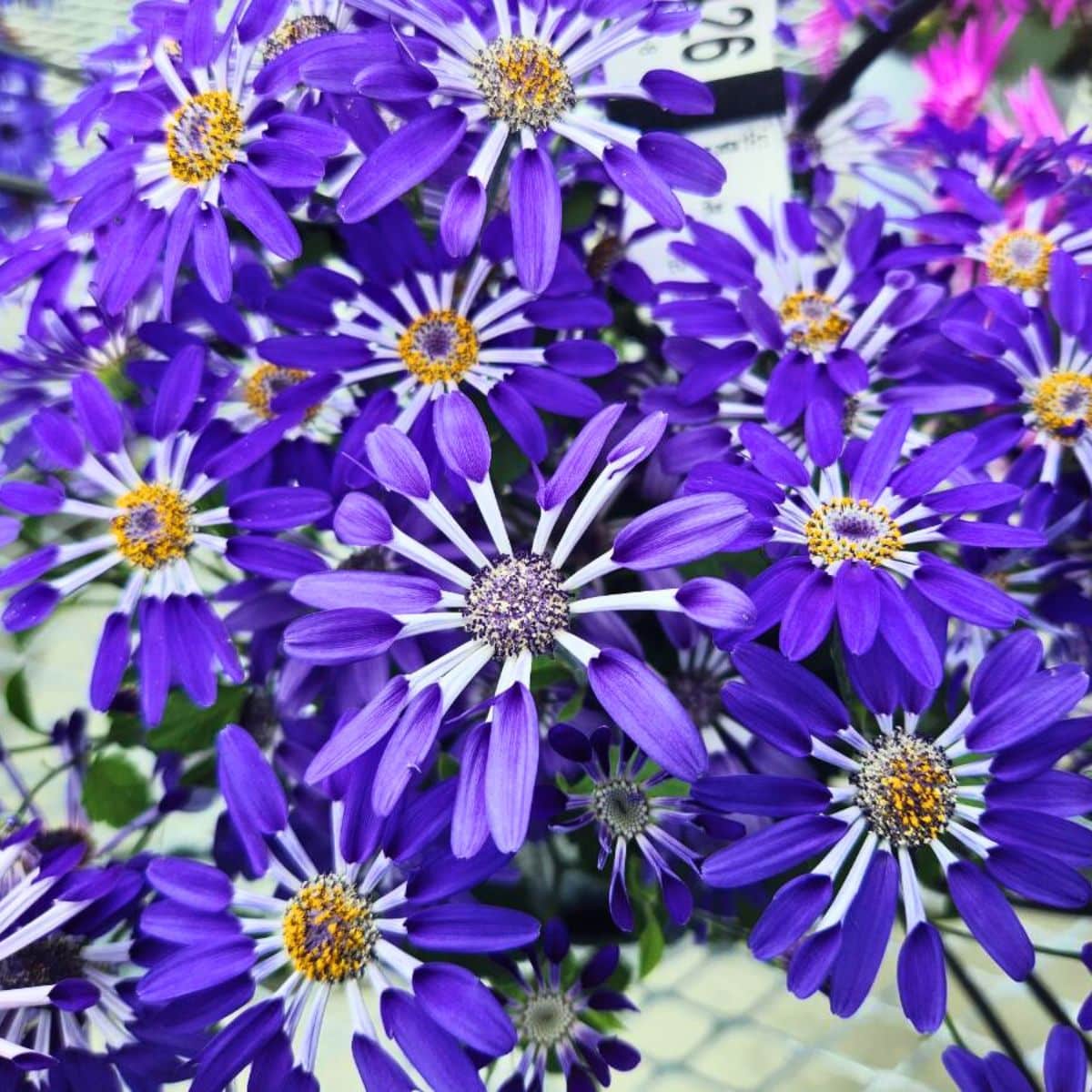
Dillye
How about annuals-million bells?